
What is Preserved Rose
Roses are often associated with love, romance, and beauty. They have been used for centuries to express affection and admiration. Unfortunately, fresh-cut roses only last for a few days before wilting and losing their beauty. This has led to the popularity of preserved roses.
Preserved roses are real roses that have undergone a special preservation process that allows them to maintain their natural beauty and freshness for up to a year or longer. The preservation process involves treating the roses with a special solution that replaces the natural sap and moisture in the plant. This process allows the roses to maintain their natural shape, texture, and colour, while also extending their lifespan.
Preserved roses come in various shapes, sizes, and colours, making it easy to find one that suits your taste. They can be used for a variety of occasions, such as weddings, anniversaries, birthdays, and Valentine's Day. Preserved roses can also be used as a decorative element in your home or office, adding a touch of elegance and sophistication.
One of the main advantages of preserved roses is their longevity. Unlike fresh-cut roses, which wilt and require frequent replacement, preserved roses can last for up to a year or longer with proper care. This makes them a cost-effective option for those who want to enjoy the beauty of roses year-round.
Preserved roses are also eco-friendly as they do not require frequent replacement, reducing the amount of waste produced. They are also pesticide-free, making them safe for both people and the environment.
Caring for preserved roses is relatively easy. They should be kept away from direct sunlight, high humidity, and extreme temperatures. They should also be kept in a dry and dust-free environment. To clean them, gently wipe them with a soft cloth or brush.
In conclusion, preserved roses are a timeless beauty that lasts. They offer a cost-effective, eco-friendly, and low-maintenance alternative to fresh-cut roses while maintaining their natural beauty and fragrance. Whether used for special occasions or as a decorative element in your home or office, preserved roses are sure to add an elegant touch to any space.
Preserved roses are real roses that have undergone a special preservation process that allows them to maintain their natural beauty and freshness for up to a year or longer. The preservation process involves treating the roses with a special solution that replaces the natural sap and moisture in the plant. This process allows the roses to maintain their natural shape, texture, and colour, while also extending their lifespan.
Preserved roses come in various shapes, sizes, and colours, making it easy to find one that suits your taste. They can be used for a variety of occasions, such as weddings, anniversaries, birthdays, and Valentine's Day. Preserved roses can also be used as a decorative element in your home or office, adding a touch of elegance and sophistication.
One of the main advantages of preserved roses is their longevity. Unlike fresh-cut roses, which wilt and require frequent replacement, preserved roses can last for up to a year or longer with proper care. This makes them a cost-effective option for those who want to enjoy the beauty of roses year-round.
Preserved roses are also eco-friendly as they do not require frequent replacement, reducing the amount of waste produced. They are also pesticide-free, making them safe for both people and the environment.
Caring for preserved roses is relatively easy. They should be kept away from direct sunlight, high humidity, and extreme temperatures. They should also be kept in a dry and dust-free environment. To clean them, gently wipe them with a soft cloth or brush.
In conclusion, preserved roses are a timeless beauty that lasts. They offer a cost-effective, eco-friendly, and low-maintenance alternative to fresh-cut roses while maintaining their natural beauty and fragrance. Whether used for special occasions or as a decorative element in your home or office, preserved roses are sure to add an elegant touch to any space.